Brits keep getting arrested for tweets. Elon Musk is (part of) the reason.: ‘…by refusing to even attempt to regulate social media networks directly, the government has tacitly accepted that police will be left to police unmoderated social networks directly’
Recently I read:
King of slop: How anti-migrant AI content made one Sri Lankan influencer rich: He now teaches a course on how to leverage that anti immigrant sentiment in Britain to make huge profits.
‘Too little, too late’: damning report condemns UK’s Covid response: The findings of part 2 of the Covid enquiry.
📺 Watched season 1 of The Traitors.
A reality show where by day a group of strangers complete missions to build up a prize pot, and by night they viciously accuse each other of treachery in order to eject them from the show entirely.
Which is fair enough, because a few of them are in fact traitors. Claudia Winkelman secretly assigned them that role at the start. The viewer knows who they are, the participants do not. They have to figure it out by whatever means they can. Each night they must vote out the person they collectively believe is most traitorous. Of course, to maintain their subterfuge the traitors also have to pretend that’s what they’re doing too and put their public votes in too.
If the “faithful” vote out all the traitors then they share the prize pot. But if even one traitor remains by the end of the series then the surviving traitors get it all.
Each night whilst the others sleep the anonymous traitors also get to metaphorically kill one of the contestants, kicking them off the show without the ability to defend themselves.
Honestly, it feels a little grim and exploitative to watch. I really hope there’s a pile of expert psychologists behind the scenes to help the players cope with the virulent suspicion, deception, mistrust, arguments, paranoia, confrontations and the rest of it.
But watching the participants - the genuinely legit and the traitors trying to appear as such - try to figure out who the traitors are provides incredible examples of all sorts of cognitive biases - confirmation bias, the halo effect, salience bias, a kind of pareidolia, overconfidence, the gambler’s fallacy and a ton of herd instinct to name but a few. And all this at the same time as being put into an unfamiliar place with unfamiliar people.
It’s such a fascinating example of all these psychological processes going on, some that we can probably recognise very well in ourselves if we stop and think about it for a minute in between screaming at the TV, that it turns out to be compulsive viewing. Even if it’s probably not exactly great for most of the folk involved.
It’s getting on for four months since Mahsa Amini, who had been arrested in Iran for not wearing her hijab in the style the authorities prefer, died when in the custody of the Iranian police after being beaten. The resulting protests are ongoing, at incredible personal risk to the brave souls who take part and their loved ones.
As of yesterday, Iran has now formally executed 4 protestors, the latest two likely having been tortured beforehand. But the overall death toll is far greater, with at least 516 demonstrators including 70 children known to have died. Almost 20,000 others have been arrested, hundreds of whom may face the death penalty.
Today’s Observer reports that:
NHS trusts with record waiting lists are promoting “quick and easy” private healthcare services at their own hospitals, offering patients the chance to jump year-long queues
This, whilst not a new thing, does not feel good in the midst of a growing NHS crisis, particularly if it’s on the rise. The private services that are provided - whether a £300 MRI scan or a £10,000 hip replacement - supposedly don’t impact the services the NHS provides under its public funding. But they often take place in the same premises with the same staff that you would get if you made it to the top of the public waiting list.
I’m sure there’s some technicality that allows them to say it’s not sucking resources from our still much loved public health system. But, simplistically, at the end of the day it surely is potential life-or-death British medical capacity that is exclusively available to the rich rather than the person that needs it the most.
The ideal of course would be that the NHS working conditions and funding was improved such that there was no incentive for hospitals or medical staff to operate a private practice at all. For now though, we’ll have to decide whether to laugh or cry at the Shalborune Private Health Care website’s claim that “We believe quality healthcare should be readily accessible.”
15th time lucky - the US elects a speaker of the House
After repeating the same vote 15 times over the last week, the US House of Representatives has finally managed to elect a speaker, Kevin McCarthy.
It’s been the longest contest for the position since 1859, preventing any of the real business of the House taking place whilst the battle continued.
But if it felt like a long time, it was certainly no 1855. That contest stretched on for two whole months and required 133 ballots to take place before a speaker was selected.
In the end they temporarily changed the rules so as to accept a plurality of votes as opposed to the standard absolute majority rules that require the victor to have gotten the support of at least half of the voters. This allowed Nathaniel Banks won the contest with 103 votes from a possible 214 electors.
The repeated election attempts over the past few days apparently became so tedious that the representatives elect started bringing in comics, books, iPad games and their own children in order to keep themselves entertained. Perhaps my favourite photo of the event was the below one, taken by Anna Moneymaker, showing U.S. representative Katie Porter’s research into how to live the good life.
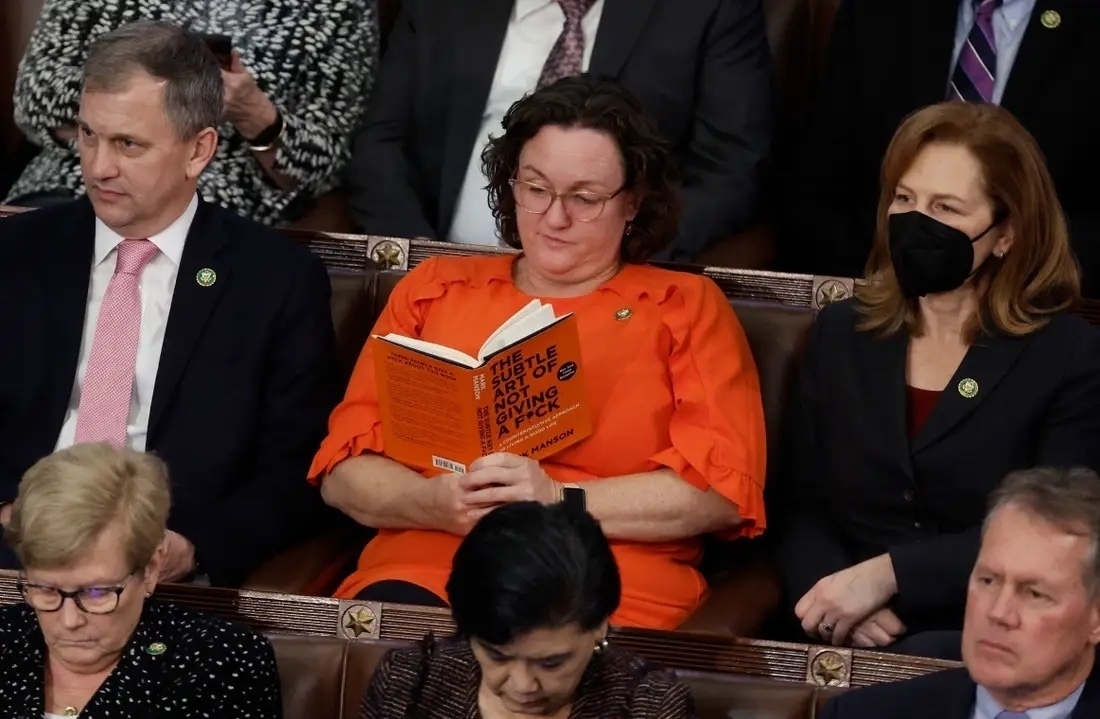

Finished reading The It Girl by Ruth Ware 📚.
A thriller set in the grounds of Oxford University, the kind of backdrop that usually appeals to me. A popular rich girl that everyone knows was murdered by a creepy college porter…or was she?
You can probably guess the general answer to that, but I didn’t figure out the specific solution until very near the end. A compulsive read with satisfying twists and turns, if not particularly challenging. Just what I needed for the holidays.
Watched season 5 of The Crown 📺.
Starting to get into the years I actually remember something about now. I love this as a way of accidentally learning the country’s history. The only problem is it seems a lot of it isn’t true. John Major seems to be particularly annoyed at it.
The show does admit to being fiction. But not knowing which bits are true makes it hard to know what to take from it. Though an article in the Atlantic is probably right to conclude that “the show is so popular that its interpretation of history will become the definitive one for millions of viewers.”
From the NYT:
Without a speaker, the United States House of Representatives essentially becomes a useless entity.
Entering day 3 of the US not really having much of a government.
Perhaps the rules on electing a speaker need revision for the future. The job is different in the UK, but here if there’s no majority for the speaker we remove the candidate with the lowest number of votes plus any with minimal support before trying again.
The Financial Times looks into why the UK’s NHS is in such a disastrous condition at present. It turns out it’s not all that complicated to understand.
- There are currently lots of ill people - a new wave of Covid-19 is once more sweeping the nation, and the flu (amongst other infectious diseases) is also surging. A real twindemic.
- We don’t have enough hospital beds. This is partly because we haven’t built enough capacity in the first place. But also because the lack of anywhere to discharge patients who still need some amount of social care (but not hospital-level care) to means that thousands of people are unnecessarily stuck in hospital.
- There are not enough staff. All parts of the workforce have staff shortages. Those that are there are exhausted, demoralized and in recent times are occasionally on strike or leaving for better opportunities elsewhere. To be clear, these problems started way before the current spate of strikes were on the agenda.
- There has not been enough investment. This is nothing new, it’s been going on for at least a decade. NHS demand is constantly rising at present, so funding needs to rise substantially beyond inflation just to maintain performance. This hasn’t happened for at least a decade. The UK has amongst the lowest healthcare capital spending as % of GDP of it’s peer countries, leaving us with fewer beds, MRI scanners, CT scanners and so on. The chart below, also from the FT, may provide a clue as to why.
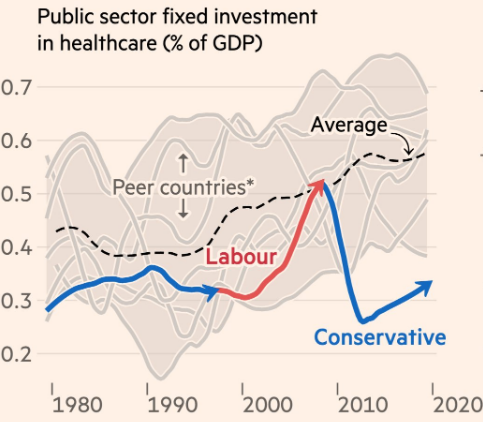
Unlike previous generations, UK and US millennials are not becoming more conservative over time
There’s a widely held belief that younger people tend to start off being politically left-wing (or liberal, socialist, whatever one wants to call the axis). Then, as time goes on and they start to age, they end up with more conservative views and political preferences.
This trend is encapsulated in a maxim whose origin and exact wording is much quibbled over but often turns up in this sort of form.
A man who is not a Liberal at sixteen has no heart; a man who is not a Conservative at sixty has no head.
Personally I hope and trust the implied value judgement isn’t true, otherwise, sorry, looks like I’m just getting stupider as I get older.
But, treating it as purely descriptive of a trend, the idea that people tend to get more conservative when they get older does usually seem to be true. Of course it isn’t necessarily their age that causes these changes; it may be to do with the fact that people’s wealth, status, position in life, psychology and so on tends to alter in an on-average predictable way as they get older.
However, John Burn-Murdoch of the FT notes that it’s just not happening that way for UK and US millennials.
They started off liberal as other generations did. But now, even though the older ones are now 40+ years old, they’re still very liberal, compared to the rest of the population at least.
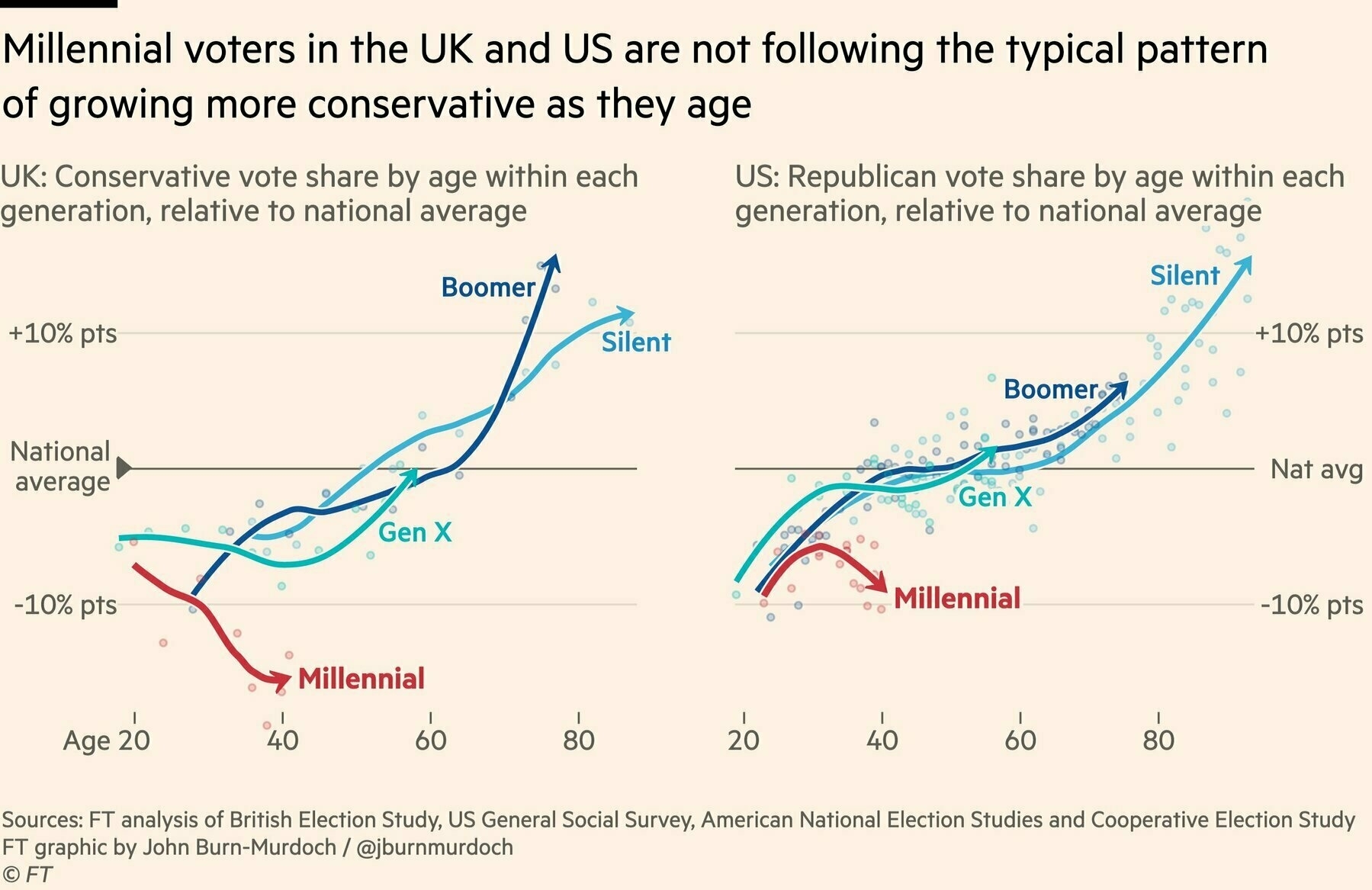
Why so? Burn-Murdoch hypothesises that this is a cohort effect due to British and US millennials entering adulthood during the aftermath of the financial crisis. They emerge into an economic environment where generating enough wealth to, for example, own a home is often a ludicrous pipe-dream.
The primary UK and US conservative party’s respective fixation on culture war topics probably also doesn’t help them much. The typical conservative side of the relevant arguments tends to be less attractive to more academically educated folk, and millennials are the best-educated generation at present.
Morten Støstad produced some follow-up work that showed that this trend also exists elsewhere, particularly in English-speaking countries like Australia, Canada and New Zealand. His first chart looks at English speaking countries and shows similar findings to Burn-Murdoch’s original graph.
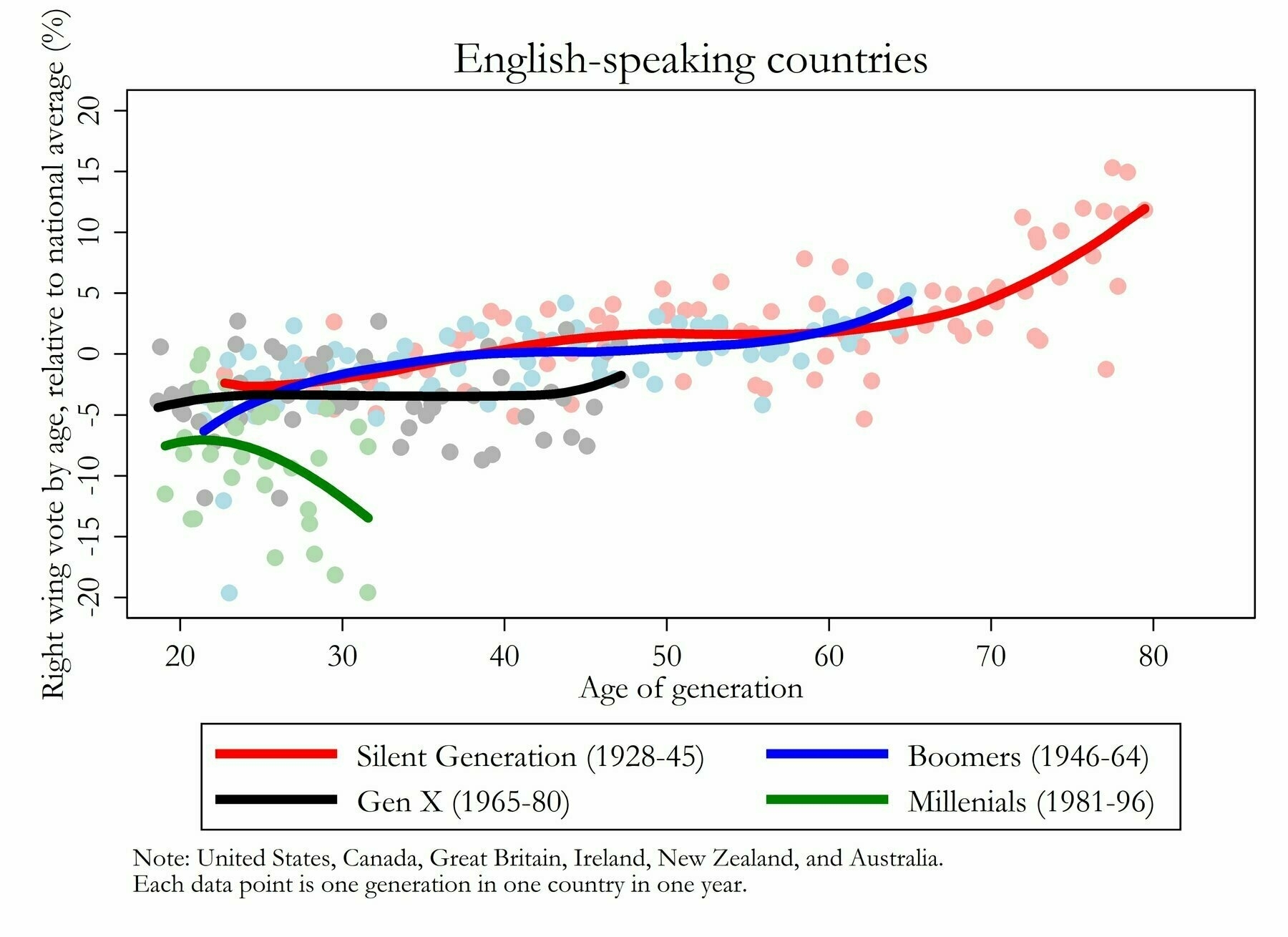
In the second though, Støstad finds that in many other non-English-speaking countries, for example Germany, France, Italy and Spain, the millennials do seem to be behaving “as normal” and becoming more conservative over time.
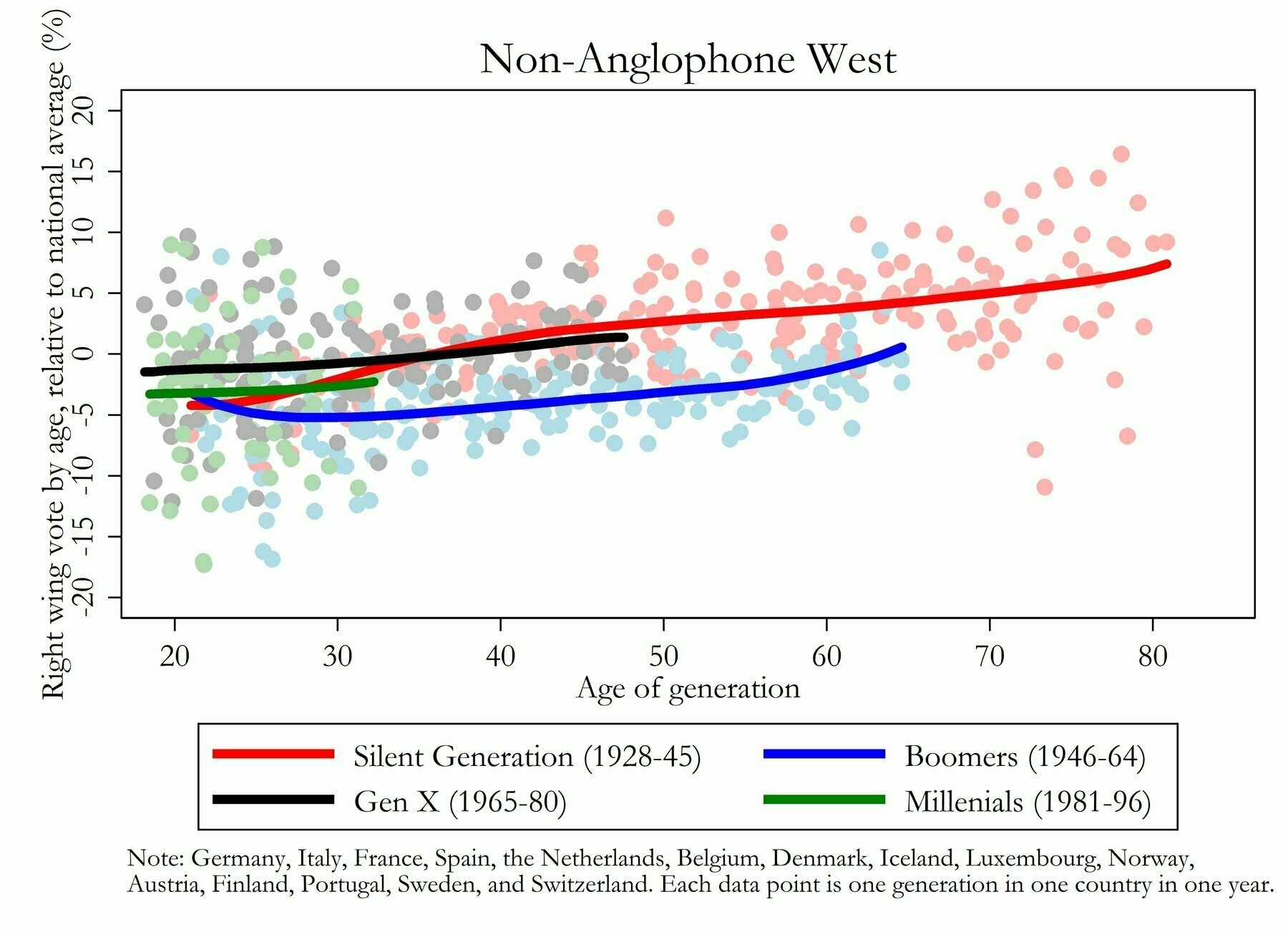
Played The Pharaoh’s Tomb from Exit: The Game 🎲.
The Exit advent calendar was so good we couldn’t stop. This one, from the same makers, is a one-session game where you attempt to solve puzzles to free yourself from an ancient Egyptian tomb. It’s rated as one of the harder ones, perhaps because you need to figure out what the puzzles even are and which order to solve them in as well as the puzzle solution itself - but we got there in the end.

Played the The Mysterious Ice Cave advent calendar from Exit: The Game 🎲.
This is an advent calendar that gives you a puzzle to solve each day of advent. The answer to each one tells you which door to open next in your attempt to escape from a catastrophic mountain avalanche.

We actually ignored the entire premise and completed it over two lengthy sessions. The puzzles were fun and varied, some harder than others but most of them felt very fair.
Something happens towards the end that was one of my favourite ever twists in these kind of games. Even more fun than a chocolate calendar for anyone that likes puzzle escape room kind of things, highly recommended.
Just remembered the time when The Beano comic issued a cease-and-desist letter to MP Jacob Rees-Mogg on the basis that he was appropriating the characteristics of their intellectual property, Dennis the Menace’s number one enemy Walter Brown, in appearance and personality.

Disappointing TIL: Drag queen superstar Ru Paul and his partner George LeBar own a ranch upon which fracking takes place.
To be fair it’s probably just the norm where they are, but it‘s a shame that even being a progressive multi-millionaire superstar isn’t enough to stop it.
Covid-19 mRNA vaccines are weakly associated with Myopericarditis - but not nearly as much as having Covid-19 is
A recent paper provides a systematic review of studies on the link between the COVID-19 mRNA vaccinations and myopericarditis in young people.
They find that there’s a low but positive association between the vaccination and later myopericarditis, particularly in males after the second dose of the vaccine. The ovreall rate of developing myopericarditis after vaccination is estimated to be between 0.3 and 5 cases per 100,000 vaccinated people.
But - and this is a huge but - this risk is far lower than the risk of developing the same condition after being infected by Covid-19 itself.
So whilst it’s important and true that there is a risk of myocarditis after the mRNA vaccines (and no conspiracy theorists, no-one sensible is covering this up - here for example is the UK government’s published advice on this matter) when making our decisions we need to remember that you’re more than 3x more likely to get myocarditis if you’re infected by Covid as opposed to if you take the vaccine and it prevents you getting Covid.
The authors also find that the severity of outcomes associated with developing myopericarditis was lower if it was associated with having developed after vaccination vs if it had developed following Covid-19. No-one in any of the surveyed studies
To me, this is all about considering which the correct baselines are for any given decision. Vaccines are not entirely risk free. But given almost everyone in the UK appears to have had Covid-19 at some point and it continues to circulate nearly 2 years later, it is usually more sensible for the average person not literally living in a bubble to compare the risks associated with the vaccine to the risks associated with getting Covid, rather than some fantasy lifestyle where there is no risk to not having the vaccine.
In summary: I believe this study suggests taking the vaccine makes it more than 3x less likely you’d suffer myopericarditis if you got the vaccine as opposed to getting Covid. Furthermore if you do contract it post-vaccination, it’s less likely to be severe than if it followed Covid. However it is slightly more likely that you’d develop it than if you went through life having never had either the vaccine or Covid-19.
Incoming disillusionment for anyone who somehow managed to convince themselves that when the US, UK et al asked the Taliban to please guarantee the protection of women after they chaotically withdrew their troops that it would actually mean something. The Taliban administration said yes, sure, of course, we’ll respect women’s rights.
In reality, so far the women of Afghanistan have been banned from attending middle school, high school, universities or certain types of religious classes. They’re also prohibited from most forms of employment. They can’t visit parks or gyms, and are obligated to wear full-coverage clothing in other public areas. There’s a concern this is a dismal journey towards even more absolute rights-stripping, such that Afghan women may soon be prohibited from leaving their homes more generally.
📽 Watched The Santa Clause 3: The Escape Clause.
Naughty Jack Frost tricks nice Santa into giving up his Christmas duties. Comedy evil ensues.
It was fine. Didn’t enjoy it as much as the previous one, tho it was after Christmas dinner so I probably slept through some parts.
Behold the Lego piano! An incredibly clever piece, taking me the best part of a year to build. I love it.
It has a ton of ‘working’ parts, perhaps providing some insight into how pianos work. You can even play tunes on it when linked to your phone, no musical skill required.

An aspect of the eternal insufficient UK housing supply crisis that I hadn’t been aware of before: housing for university students.
…there is a shortfall of 207,000 student beds, and 19 towns and cities where there is more than a 10% undersupply of beds.
The independent Pay Review Boards are not very independent
One of the drivers of the huge number of strikes the UK is currently in the midst of is that many employers are not offering annual pay rises that allow for a wage it’s possible to live a decent life on, let alone keep up spending parity with last year. Pay is not the only reason for the strikes by a long stretch, but it is a key one for many strikes.
One argument the government often respond to the public service sector strikers' pay demands with is “Hey, we don’t set the wages, we just do what the independent Pay Review boards tell us to do. Blame them!”.
The role of Pay Review Boards is to give advice to the government on pay for certain public sector workers. They cover about 45% of all public sector staff. The boards include:
- Armed forces’ pay review body (AFPRB)
- National Crime Agency remuneration review body (NCARRB)
- NHS pay review body (NHSPRB)
- Police remuneration review body (PRRB)
- Prison service pay review body (PSPRB)
- Review body on doctors’ and dentists’ remuneration (DDRB)
- Review body on senior salaries (SSRB)
- School teachers’ review body (STRB)
One immediate critique of the government’s claim that any disagreement is all the Pay Review Board’s fault is that governments don’t actually have to implement the board’s recommendations. Their output is advice that in theory the government can do what it likes with.
Whilst the norm is to follow the advice, it’s easy to find examples of where they haven’t. For instance the latest advice from the Prison Service Pay Review Body and Senior Salaries Review Body were only partially accepted. The Government has the final say so could alter the parameters if it wanted to.
But perhaps more problematic is that the government can exert a lot of influence over what the advice is going to be in the first place, to a level I wasn’t really aware of until recently.
For a start it’s the government who appoints each of the board members in the first place, with the Prime Minister being responsible for appointing the chair. But we don’t need to get into the realms of the personal to see how constrained the boards are.
Each year the relevant government minister sends a remit to the board concerned, alongside their the pay changes the government already decided it wants to make. The remit tells the board which factors they should focus on when making their decisions alongside any constraints that the government has already decided to enforce that they must bear in mind.
Sometimes the constraints are such that they exclude many of decisions the board in theory could make.
For instance, between 2013 and 2017 the public sector pay growth was limited to an average of 1%. The constraint was imposed by the government, not the pay review board. In situations like these the boards can only give advice on how to distribute that 1%.
Likewise during 2021-2022 there was a general public sector pay freeze ordered by the government for most public sector employees. The pay review boards could then only give advice on how to implement rises for types of workers the government had decided were eligible.
This year the NHS remit letter tells the board that:
…the NHS budget has already been set until 2024 to 2025. Pay awards must strike a careful balance – recognising the vital importance of public sector workers while delivering value for the taxpayer, considering private sector pay levels, not increasing the country’s debt further, and being careful not to drive prices even higher in the future.
In the current economic context, it is particularly important that you also have regard to the government’s inflation target when forming recommendations.
Thus the board is constrained to giving advice that if enacted wouldn’t increase the amount of budget the NHS would need to fulfill it. They’d also probably want to avoid using up enough of the pre-decided budget such that another aspect of the investment-starved service would suffer even more than it already is. The latter is something that can easily happen - there are many reports of, for example, the pressure schools are under to give their staff pay rises the government agreed to, but with the government failing to actually providing the extra budget needed to enact the raise. Thus some other critical part of the educational experience in this case must suffer.
The NHS remit letter this year also tells the board to ensure that their advice somehow focuses on the inflation target that the government set, rather than, say, what’s necessary for a happy, efficient, effective workforce.
This feels entirely backwards to me, and sometimes potentially impossible. How does one take the government’s inflation target into consideration at the same time as considering private sector pay levels, when the private sector is not constrained to take any note at all of the government’s inflation target in making its pay awards?
Naively, I had expected that the pay review board created its recommendations based on the need to recruit, retain and engage employees in the domain that they’re responsible for. They’d ensure that the employees have enough income to live a reasonable life, and ideally have pay roughly comparable to other similar job opportunities out there. Except of course if we’re particularly desperate to recruit and retain some roles (which we are - we’re desperate for nurses and teachers amongst others), in which case perhaps the pay or conditions would have to be improved to reflect that.
In this fantasy world, the board’s recommendations would then give input to the government to help them to figure out what budget they need to provide in order to fulfill the pay recommendations, in addition to any other investments or costs the service in question needs outside of the domain of the Pay Review Board. But in reality it looks to be more the other way around. The government can pre-set the budget and enforce constraints of its own choosing. The boards seem to be more advising on how to implement the government’s existing plans rather than enabled to provide an independent opinion as to what those plans should be in the first place.
📽 Watched The Santa Clause 2.
Shamefully I’m not a great fan of Christmas movies as a genre, They usually give me a big deju-vu feeling. But whilst this sequel-of-a-classic wasn’t very surprising, it kept me engaged and happy enough.
Plus Comet very much reminds me of our dog.
Listening to Love Sux by Avril Lavigne 🎶.
Astonishingly, it’s the 20 year anniversary of Avril’s classic album ‘Let Go’. There is an anniversary reissue but she also popped out a whole new album. Much of it might actually fit in well enough with the original, albeit this incarnation of her eternal pop punk teen angst seems a bit more up-beat and dancey in places.
If only we’d all manage to preserve ourselves as well over the past couple of decades. I mean, one of the titles even involves the word “boi”, albeit this time not a sk8r.
The moral disaster of the Qatar 2022 World Cup
The recent Qatar World Cup final was apparently one of the best ever matches to grace the competition, although sadly I forgot it was even on.
Nonetheless, it’s hard to argue that the surrounding setup was anything other than a moral disaster.
Described by the Guardian’s Barney Ronay as ‘the most costly, carbon-heavy, bloodstained, corruption-shadowed event in the history of global sport’, the honour of hosting it was granted to an authoritarian government that routinely enables the abuse of human rights.
There are essentially no LGBT rights in Qatar, with prison sentences handed out for engaging in “homosexual practices”. Even just existing can lead to imprisonment, beating and harassment from the security forces. Anti LGBT legislation was followed to the almost-comical-if-it-wasn’t-real extent that you weren’t allowed to wear rainbow coloured clothes to the match.
The event’s multiple new stadiums and surrounding infrastructure were built in literally deadly workplace conditions involving near slavery in many instances.
The environmental damage is also likely to be absurdly huge, despite the incredible amount of greenwashing.
It’s particularly upsetting to reflect on the point that perhaps all this isn’t a weird aberration. The fact Qatar was selected as the host made the associated horror show particularly visible and disturbing. But, unfortunately, abusing desperate humans alongside the climate that sustains us all in order to put on a massively profitable and image-enhancing show is far more universal than that.
Back to Ronay’s article :
Qatar didn’t invent this world, didn’t invent migrant labour, didn’t invent global capitalism. It is simply the most zealous of late adopters, selling brutal carbon-fed hyper-capitalism back to the world in its final form
The whole event has the same ethos of “hardcore capitalism eating itself” that most cryptocurrency efforts to date often inspire in me. With that technology we burn the planet in order to enforce artificial scarcity over a made-up construct with the predictable outcome of further exacerbating chronic wealth inequality.
Health chiefs made the remarkable intervention of asking people to avoid getting drunk during the strike, four days before Christmas, as the potential for disruption in transporting people to hospital is so severe
Concerned that public support for the strikes might plummet - is this a sacrifice too far for the Great British public?
Enjoyed seeing the pretty Christmas lights on a recent visit to Lincoln. Probably could have benefited from a spell check though 🤦♂️ .
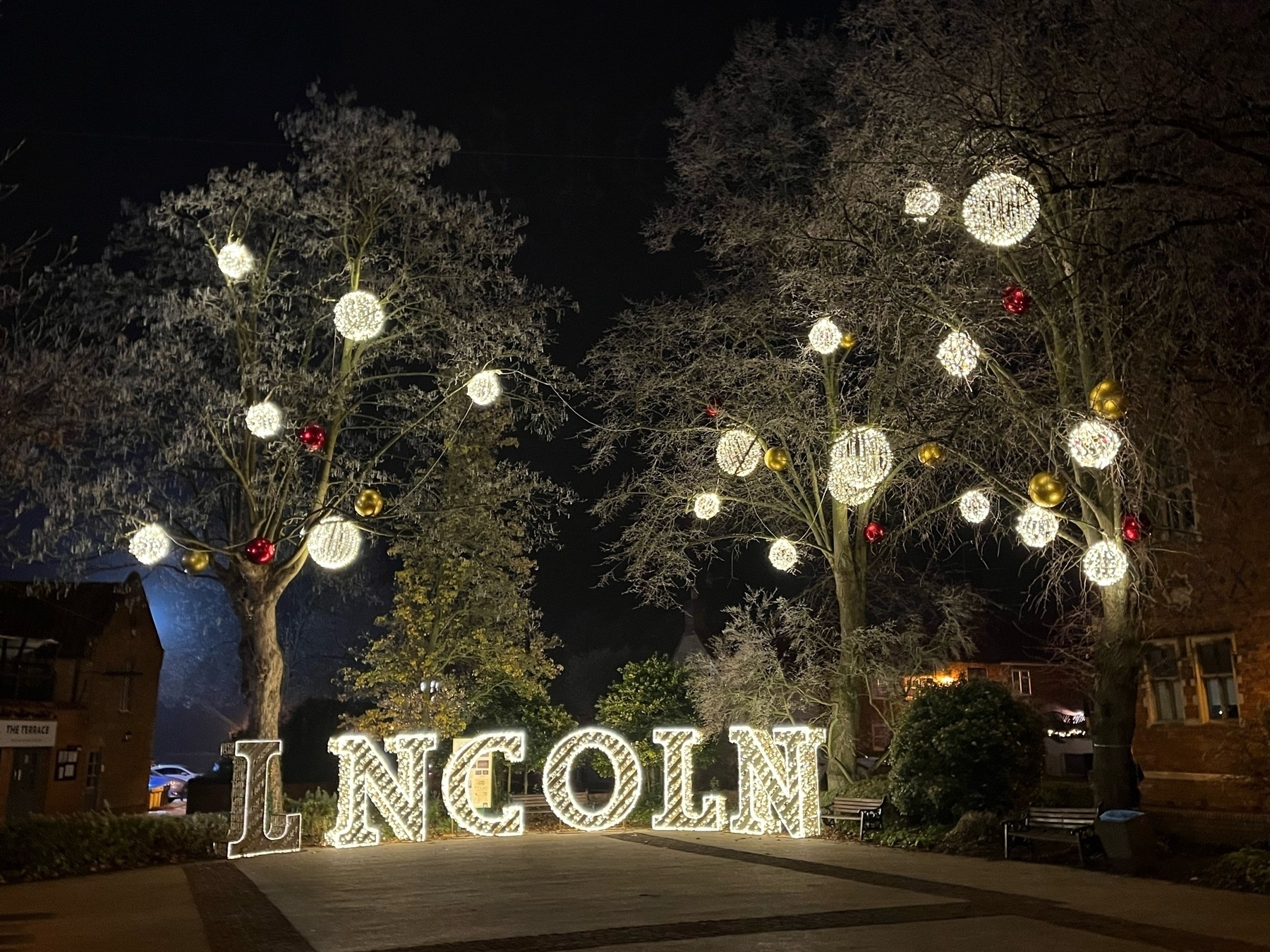
Mental illness as a 'sane response to an insane world'

One idea that has been circling around my head a lot recently is how we commonly treat the recent “epidemic” of mental illness as something specifically pertaining to the individual sufferers concerned. We’re often inclined, however compassionately, to attributing their suffering to their personal “problematic” biology, their brain chemistry or their thinking patterns. We don’t step back and look at the potentially larger scale social and political causes of it.
In the book Life Isn’t Binary, Barker and Iantaffi provide a phrasing of this issue that has stuck with me:
Perhaps we would do well to view the depression, anxiety and other mental health struggles that most of us grapple with at some point as a sane response to an insane world.
The pain and struggles are entirely real, there’s no questioning of that. But in many cases they’re also understandable without recourse to individual “abnormalities”. They have causes; logical, rational and predictable antecedents.
Oftentimes they may in fact be the result of the body and brain working perfectly normally given the situation they find themselves in. In Lost Connections, Hari notes:
It is no measure of health to be well-adjusted to a sick society.
We’ve evolved responses to dangers that may not be “useful” for today’s challenges in many cases. But the fact that people have those responses is necessarily not a sign of bad or unusual health. They’re a perfectly normal response to situations that are perceived to pose some kind of threat.
In some instances the threats may not be real but rather the result of some misunderstanding. In these cases perhaps a valid avenue of treatment might be to try and help someone change how they think about a situation. But on other occasions times the perceived threat may in fact be very real.
As is obvious from the above, this kind of issue has been touched upon to some extent by several books and articles I’ve read in recent times. But it’s not clear to me that it’s reached the point of full acceptance, or that the conclusions that logically follow from this train of thinking have been concretely transformed into policy, perhaps outside of a few trials.
This is not necessarily through the very real historical lack of compassion and understanding that has confronted those afflicted with mental health issues. In fact, some of the resistance to this idea might be the concern that taking this view too far to the extremes could result in the ignoring of people’s very individual needs, or a failure to provide the individual-level treatments are in fact needed in some cases.
A quote I saw somewhere taken from a psychotherapist called D. W. Winnicott’s book ‘Human Nature’, which runs as follows:
The capacity to become depressed…is something that is not inborn nor is it an illness; it comes as an achievement of healthy emotional growth…the fact is that life itself is difficult. Probably the greatest suffering in the human world is the suffering of normal or healthy or mature persons.
I think that at least the first part of that must be true. No-one that I’m aware of thinks that their own life is entirely easy, uncomplicated and stress-free. But it’s often hard for us to viscerally remember that fact when it comes to understanding and interacting with other people. This is especially the case if we feel like someone mistreated us, that they’re of “bad character” (whatever that means) or that they’re somehow getting a better deal out of life than us. Even at the extremes, is there really any reason to believe that the richest man in the world, Elon Musk is presently living a happy and care-free life (actually maybe he’s only second richest now)?
If we accept that most, possibly all, people feel that their life is in some way a struggle then wouldn’t we find it strange if they didn’t ever have any kind of negative psychological response? That might feel like a disorder in itself.
Perhaps part of the controversy from the compassionate side might be a fear that, in understanding that it’s perfectly normal to have the capacity to suffer from what we now classify as mental illness one, could misguidedly come to the conclusion that, hey, we just need to live with it. Sure you’re suffering, maybe a lot more than most people - but it’s a perfect normal phenomenon. You don’t need treatment. There’s nothing we should or even could do about it. That would be entirely the wrong conclusion to draw.
But very little of import in this discussion is the result of a unmodifiable natural law. Societies have changed over time.
By many metrics they tend to improve in many ways - this famously being a core thesis of books like Pinker’s “The Better Angels of our Nature” as well as his more recent work. It does seem to me that it’s very often a fallacy to think “things must have been better in every way a few decades ago” or “if we lived a life more like someone in the past would have then we’d be guaranteed happiness”. But even if the direction has generally been positive in the past, then there’s no guarantee it always will be. Besides, there will always be hiccups, mis-steps and temporary deviations into potential despair along the way.
But the fact that there have been changes in the past show us that there can be changes in the future. I often wonder what people 200 years from now will look back on us and think “oh man, that’s wild that they used to do that. How could they possibly believe that was OK?” about in the same way that we might look back on people from past centuries, wondering how they could ever believe what they needed to believe in order behave in ways that by today’s standards we would consider illogical, foolish, and cruel.
But another bad conclusion one can draw, this time from not taking social or other macro causes of mental distress into account, comes from the idea that those who get diagnosed as depressed, anxious and so on are the unhappy victims of random bad brain chemistry or invalid patters of thought. This idea might lead people to infer that the individual medicalisation of patients is a necessary and sufficient manner of addressing their pain.
I’m absolutely not against the use of pharmaceuticals or other individual-level medical therapies of any helpful kind. Sometimes their usage may be imperative, urgent, and life saving. But in the cases where there is a plausible social or environmental cause for the condition - let’s say abject loneliness, poverty-induced fear and exhaustion, anxiety resulting from racial abuse, the legacy of past traumas, all those kind of things - giving someone individual medical “brain treatment” doesn’t do anything about removing the cause. The same cause that likely wrecks the life of many other people in addition to the one who summoned up the strength to visit a doctor and had the access to do so.
Most damningly, limiting ourselves to individually medicalising the sufferers of a structural effect lets us off the hook from even addressing the causes. Often this is convenient, in the sense that truly addressing some structural or social determinants of disease may involve solutions that are politically challenging to even discuss in the current environment, let alone carry out.
As just one example of what we know could be done, at one point in the Covid-19 pandemic the UK made a concerted and effective effort to “solve” homelessness. Being without accommodation is a life situation which is highly associated with the suffering of mental health disorders, both as cause and effect. But with this initiative, street homelessness was apparently almost eliminated and tens of thousands of people were moved from emergency to longer term accommodation.
It seems like in general the policy worked! However the Government chose to end the scheme. Last year a quarter of the beneficiaries of the scheme are back to having no accommodation It’s feared that the 2022 cost of living crisis will cause a “tidal wave” of new homelessness, and given the acknowledged connection between homelessness and mental illness, an unnecessary spike in mental suffering.
A recent New York Times opinion article provided the following metaphor:
If someone is driving through a crowd, running people over, the smart move is not to declare an epidemic of people suffering from Got Run Over by a Car Syndrome and go searching for the underlying biological mechanism that must be causing it. You have to treat the very real suffering that is happening in the bodies of the people affected, obviously, but the key point is this: You’re going to have to stop the guy running over people with the car.
If something about some people’s lives today is causing them mental anguish, then we certainly need to treat that suffering. But a solution that doesn’t also stop the metaphorical guy who is mowing down their well-being is never going to be sustainable, complete or robust.
Therapising someone who’s anxiety is exacerbated by for instance food insecurity, who knows that the only way they can afford to eat even low-quality unhealthful food is dependent on them keeping their low-paid, precarious and abusive job, may potentially help their inner state in the short term. But it doesn’t do anything to remove the actual, real, threat of them in truth not being able live without exposing themselves to abusive conditions - conditions that they don’t have any agency over; however unpleasant the job is, it might taken away from them at someone else’s whim. Someone who didn’t respond to those prospects with a substantial level of at least worry and trepidation would seem unusual to me.
If their response is damaging to their own quality of life then they surely must be individually helped. But we must also address whatever has led us to a place where their ability to lead a fulfilling life depends on your luck and ability to take employment at any personal cost. What led us to a place where more than 1 in 5 millennials feel like they have no friends? A society where financial security depends in part upon your race? That those who live in some areas die many years earlier than those that live elsewhere, even in a small and rich country? A land where the economic consequences of the Covid-19 pandemic on you were more severe if you were already poorer beforehand?
This becomes even clearer to me when we look at patterns of mental health issues. These sorts of statistics are always a little hard to interpret because to feature in such a dataset often requires you to have had access to and attended certain types of healthcare. It may even depend the specific medical practitioner you see when you do so.
In The Body Keeps The Score, the author writes that despite the best attempts of psychiatrists to define and categorise mental illnesses, for example in the famous Diagnostic and Statistical Manual of Mental Disorders (DSM), specific diagnoses often come down to tallying up a list of symptoms and may depend as much on the mindset of the doctor concerned as on the patient. The fact that new editions of the DSM categorisation come out every so often with new and altered definitions reinforces the point that we haven’t fully solved how to categorise mental illness, let alone treat it.
In her book, All Our Relations, Tanya Talaga draws a direct line between the incredibly high rate of that most extreme outcome of adverse mental health, suicide, and the social conditions that the Indigenous peoples of countries like Canada and the US find now themselves in.
She reports that in Canada, suicide and self-harm is now the leading cause of death of First Nations people up to the age of 44. Rates are more than 5 times higher than a comparison group of non-Indigenous people for males aged between 15-24.
But this wasn’t always the case. The suicide epidemic in those communities is a modern phenomenon, seen only after the introduction of forced resettlement and the “Indian Residential schools”.
The natural brain biochemistry of these folk didn’t suddenly change overnight. No genetic mutation suddenly somehow retrospectively swept their culture. Rather, their way of life, their beliefs, their freedoms, hopes and dreams had been assaulted by the political decisions and resulting social conditions at the time.
Today Indigenous children are more likely to grow up without access to the basic determinants of health, which Talaga lists as including income, status, clean water and air, decent accommodation, supportive families and communities, education, healthcare and a connection to their traditions. The absence of these basics negatively affects their physical, mental and social health.
A related critique of the “DSM-5” type categorisation approach to mental illness was made by the British Psychological society in their response to the development of the that system.
…systems such as this are based on identifying problems as located within individuals. This misses the relational context of problems and the undeniable social causation of many such problems
In all this I want to remember that it’s very likely that some mental illness does have a biochemical, brain or genetic basis that might be directly treatable in more conventional ways. Few people seem to argue against the idea that pharmaceuticals in this sphere do have their uses. They may be necessary even when the underlying cause of an issue isn’t due to unusual brain chemistry. But cannot be the be-all and end-all of interventions when the cause of the condition being treated lies outside of the person.
Furthermore, it may bring comfort to those with particular suffering to have a medicalised label. If nothing else it provides a valuable recognition that those around them can acknowledge, understand and treat. Perhaps a sense that your pain is real, and can be addressed. It may be reassuring in some sense to feel biologically unlucky as opposed to blameworthy. But of course issue there is more about the invalid and illogical misuse of blame concepts.
A categorisation also provides a potential identity that allows them to seek out a peer group of those who face similar battles. This might be beneficial either in terms of learning strategies to tackle the issue directly, or by providing a social group of people with a common interest who you know understand rather than stigmatise you.
Despite my general skepticism about the benefits of social networks, this does seem like one possible use of these technologies, perhaps especially for rarer conditions. In 2016, Naslund et al. wrote
People with serious mental illness report benefits from interacting with peers online from greater social connectedness, feelings of group belonging and by sharing personal stories and strategies for coping with day-to-day challenges of living with a mental illness.
A potential downside I can imagine may be risk of the person ending up feeling like “they are their illness” and that it’s a fixed and permanent trait as opposed to something that can often be addressed. It may also be damaging if the idea that those outside the peer group can’t help, and perhaps are even not to be trusted is cultivated. But overall, these types of peer groups are likely invaluable - “given the evidence to date, the benefits of online peer-to-peer support appear to outweigh the potential risks”, to quote the Naslund paper.
Whilst I’m don’t get the sense that this way of thinking is particularly routine in healthcare today, there have been a few interventions that do seem to acknowledge the social, political and environmental causes and exacerbations of mental health issues.
Recently the results of a National Health Service intervention that involved the prescribing of heating reported success. “Prescribing heating” simply means paying the home heating bills for patients who cannot afford to do so themselves. This is an increasing number given the dramatic increase in energy costs in recent times.
Many illnesses and other reductions in quality of life are caused or exacerbated by living in cold environs. It’s estimated that 10,000 people a year die of cold home related issues. Dealing with the other health consequences of cold homes costs the NHS £860 million a year. Most of the reporting on this trial addresses physical illnesses, such as respiratory or circulatory conditions, rather than mental illnesses, but the report that calculated the £860 million figure does note that living in cold or otherwise inadequate homes can also have a severe impact on mental health.
In 2018 we saw a “social prescribing” initiative that would enable doctors to prescribe therapeutic art or hobby based treatments for instance. Related trials so far have shown improvements in patients physical and mental health. This approach is one potential plank of the Government’s anti-loneliness strategy.
The NHS notes that social prescribing is effective for a wide range of people, including those who need support with their mental health. The Royal College of Psychiatrists agrees, reporting) that social prescribing helps people connect to their community in a way that can improve their health, both physical and mental.
Of course, as with almost anything, there’s a risk of taking this idea too far. We must avoid people being “socially-prescribed” to on the basis that it’s a simpler or cheaper option than the alternatives (if it is - I don’t know).
It will not be a suitable solution for everyone. The Royal College of Psychiatrists notes that it, in isolation, social prescribing will only likely be sufficient treatment for patients with mild mental illnesses. For moderate or severe conditions, more traditional forms of therapy and medication are still usually to be recommended, with social prescribing being considered as an accompaniment if suitable. Social prescribing might potentially also play a role in the prevention of these conditions originating in the first place.
Social prescribing is of course only one intervention that addresses the idea that the way we live is causing many mental health issues.
Many, perhaps most, future interventions may take place outside of the healthcare system. This is particularly the case if we continue to imagine healthcare as being something that you access when you’re already ill rather than a service that helps lessens the likelihood of the illness in the first pace.
One example currently outside of the domain of the UK healthcare system - although the line often seems somewhat arbitrary to me - are food banks. Food banks exist to directly address the problem of people going hungry by giving free food parcels to people who are in such a state of destitution that they cannot otherwise obtain food. In the UK these are typically run by charities or NGOs, such the Trussell Trust, who have stepped up where the state has dramatically and unnecessarily failed its citizenry.
According to a report by mental health social worker Tom Pollard, the increasing demand for food banks is driven simply by an increasing number people not having enough income to buy food. This phenomena is growing dramatically, driven by conscious, visible, political choices such as cuts to social security support, insecure employment practices and rising house costs. 43% of households on Universal Credit benefits experienced food insecurity in 2019-2020.
Intuitively this seems a solvable problem. As the report says:
It is not right that people need to rely on charity handouts to get by. Our social security system, at both a local and national level, and our economy, should ensure that everyone is able to afford food and other basics.
In the mean time, the struggle to not starve, the lack of personal agency, the feeling of failure and the cognitive effort required to jump through the necessary bureaucratic hoops to access these services can come at a great cost to mental health. And all this to typically receive a one-off package containing up to 3 days worth of food - enough to not starve to death right now, but it surely can’t do a lot for the person’s ongoing peace of mind and ability to live a fulfilling life.
In the words of the Big Issue’s writeup of the report,
Soaring UK poverty forcing people to use food banks is creating a ‘toxic environment’ for their mental health.
A third of households relying on these services include someone with mental health problems.
Furthermore, the use of foodbanks is stigmatised by some, with potential users reporting feelings of shame, anxiety and embarrassment at the thought of even visiting such an establishment. The film “I, Daniel Blake” portrays this kind of situation, and many of the other life-crushing effects of poverty in an effective and harrowing way.
There are certainly people who don’t seek even this most meagre assistance due to the shame they feel. The same goes for welfare benefits in general, as the recipients of those too are routinely shamed and abused by our elected officials, the media and the public at large.
A few years ago, polling showed that most claimants feel shame sometimes, most or all of the time, with one in four potential claimants deferring or declining to apply for the assistance they are absolutely entitled to for this reason. Analysis suggested that a ball-park figure of £10-15 billion per year in benefits went unclaimed in 2016. For what it’s worth, this is roughly 5-8x the estimate for the value of benefit fraud during the same period, if I read the Government report correctly.
As it stands, one study found an association between how many people are claiming benefits in an area and the amount of prescriptions for anti-depressants. For every 1% increase in people in a Local Authority area claiming Universal Credit there was a 5.6% increase in anti-depressants.
With all these type of associative studies, the direction of causality is usually not clear. Does having mental health problems make you more likely to need to claim benefits? Or does the experience of claiming benefits and the limits of the life you can live on them lead to mental health problems? My assumption is that both are true to some extent, although I haven’t looked much into work in this area.
The Covid Realities project did however find instances of people describing the latter:
…parents and carers living on a low-income reported experiences of stress, anxiety and low mood associated with claiming Universal Credit, connected to financial insecurity and the overall inadequacy of payments.
In any case, there is clearly a set of people that both have distressing mental health conditions and live in poverty. Solving the latter is a moral imperative in its own right, and the direction of evidence would suggest that doing so would likely “automatically” improve the former.
For those that are able to claim Universal Credit, the Government increased the amount of some entitlements by £20 in 2020 in response to the Covid-19 pandemic and associated lockdowns. This was presumably intended to assist with the increased financial pressure on those that already received benefits, and also those that the pandemic would end up forcing into the position of requiring them. After a year of Covid-19 raging the number of Universal Credit claimants had nearly doubled, up to 6 million recipients.
This £20 boost was well-received by anti-poverty campaigners. However in October 2021, despite the pandemic very much still being with us and inflation making the cost of living ever more unbearable for the non-wealthy, the Government chose to abolish even that £20 increase.
Many experts and campaign groups pleaded with them to not go ahead with that cut, including Mental Health UK, who highlighted the dangerous loop effect between mental health and poverty.
This is not just a financial issue; we’re very concerned these pressures will result in more people seeing their mental health problems spiral, in turn making it difficult to manage their money worries and sending them deeper into the red.
The British Psychological Society had similar concerns:
This decision will see health inequalities widen, placing more pressure on our already stretched and underfunded public services, as well as intensifying the mental health difficulties of people already struggling with rising debts, reduced income and soaring living costs.
Nonetheless, the Government went ahead with the cut, forcing people’s lives into trajectories likely to cause or exacerbate mental illness. This was a political choice to knowingly create an environment that endangered mental health. Sure, some of the fallout symptomology might be treatable with medication (which comes with its own costs, financial and otherwise). But the suffering may never have occurred in the first place had we not consciously changed our societal environment in such a way.
There are clearly numerous other ways we might think about enabling poorer people access to money, unhoused people to accommodation, lonely people to socialisation, hungry people to food, exploited workers to quality jobs, people who suffer prejudice to equity, people with disabilities to a full and happy life and so on. Many of these might be much more creative and affirming than simply providing food and income enough to live a tolerable life to those who need it - although doing that might well be a good, necessary and urgent first step given the dire situation we currently find ourselves in.
But however we choose to address the subject, whilst taking care not to remove or reduce access to conventional medical therapies to those that need them, putting the foundations in place to solve the structural issues that in part cause the need in the first place is surely the sane response to an insane state of affairs.